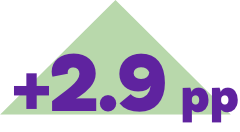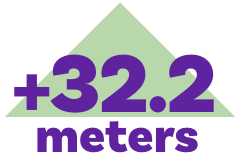
MAKE THE NEX MOVE FOR
YOUR PATIENTS WITH LOPD
NEXVIAZYME is a monotherapy* for your patients with
LOPD who are newly diagnosed or on another ERT1
*Not including premedication or pretreatment
ERT=enzyme replacement therapy; LOPD=late-onset Pompe disease.
About LOPD
LOPD is a degenerative neuromuscular disorder characterized by muscle dysfunction1
Late-onset pompe disease (LOPD) is caused by pathogenic variants in the acid alpha glucosidase (GAA) gene, resulting in GAA enzyme deficiency. GAA enzyme deficiency leads to impaired lysosmal glycogen breakdown.1

Role of the M6P pathway in routing GAA enzyme into the lysosome2
GAA deficiency results in glycogen accumulation in lysosomes2
Desnick R, Schuchman E. Nat Rev Genet. 2002;3(12):954-966.
LOPD CAN CAUSE IRREVERSIBLE DECLINE IN:3,4
|
|
The goal of treating LOPD is the improvement or stabilization of breathing and walking1
Historically, many patients on ERT showed an initial benefit, followed by a plateau or decline after 3-5 years5
In a long-term study evaluating the effects of an ERT in adults with LOPD5:
Over 10 years
 of patients experienced a secondary
of patients experienced a secondary
decline in both FVC and 6MWT
 declined in either FVC,
declined in either FVC,
6MWT, or both
Individual experience varied
6MWT=6-minute walk test; FVC=forced vital capacity.

Continual monitoring, even if your patient appears to be doing well, may help identify at-risk patients sooner.1
References
- Llerena JC Jr, Nascimento OJM, Oliveira ASB, et al. Arq Neuropsiquiatr. 2016;74(2):166-176.
- Desnick R, Schuchman E. Nat Rev Genet. 2002;3(12):954-966.
- American Association of Neuromuscular & Electrodiagnostic Medicine. Muscle Nerve. 2009;40(1):149-160.
- Kishnani PS, Steiner RD, Bali D, et al. Genet Med. 2006;8(5):267-288.
- Harlaar L, Hogrel JY, Perniconi B, et al. Neurology. 2019;93(19):e1756-e1767.
The Nex Step in ERT Technology:
NEXVIAZYME, an M6P-Enriched ERT
MECHANISM OF ACTION
NEXVIAZYME is an ERT for LOPD engineered with 15x more M6P than alglucosidase alfa.1,2,*
WHAT IS M6P?

Mannose-6-phosphate, or M6P, is a residue that binds to muscle cell receptors
(called CI-MPRs), mediating the uptake of ERT into muscle cells.3-5

SEE HOW NEXVIAZYME WORKS




*NEXVIAZYME is engineered to have ~15 mol M6P per mol enzyme. Alglucosidase alfa is engineered to have ~1 mol M6P per mol enzyme.1,2
NEXVIAZYME Pharmacodynamics
ROLE IN GLYCOGEN DEGRADATION
NEXVIAZYME demonstrated a reduction in urinary glucose tetrasaccharide (Glc4) levels during a phase 3 clinical trial.1
CHANGE IN URINARY GLC4 OVER 49 WEEKS

Mean percentage change in urinary Glc4 concentrations from baseline to week 49
The baseline mean urinary Glc4 concentration was 12.7 mmol/mol Cr and 8.7 mmol/mol Cr in NEXVIAZYME and alglucosidase alfa treatment groups, respectively.1

reduction in urinary
Glc4 concentration
over 49 weeks in a
phase 3 clinical trial
in treatment-naive
patients with LOPD1
Urinary Glc4 concentrations
were normalized by urine
creatinine and reported as
mmol Glc4/mol creatinine.1
WHAT IS GLC4?

In patients with late-onset Pompe disease, excess glycogen is degraded to hexose tetrasaccharide
(Hex4), which is then excreted in urine. The urinary Hex4 assay measures its major component, Glc4.1
OBSERVING GLC4 REDUCTIONS LONG-TERM
During the extended 145-week treatment period, urinary Glc4 was measured in patients who had been receiving NEXVIAZYME since baseline and in those who switched from alglucosidase alfa.1,9
URINARY Glc4 % CHANGE FROM BASELINE 1,9

53% mean difference observed in urinary Glc4 from baseline to week 145 for those who remained on NEXVIAZYME1,9

48% mean difference observed in urinary Glc4 from baseline to week 145 for those who switched to NEXVIAZYME1,9
*Nexviazyme Arm: Participants who received NEXVIAZYME in the PAP continued on NEXVIAZYME during ETP.
†Switch Arm: Participants who received alglucosidase alfa in the PAP and switched to NEXVIAZYME during ETP.
Cr=creatinine; PAP=primary analysis period; SD=standard deviation.
Clinical Trial Results
COMET TRIAL: STUDYING THE NEX MOVE IN PATIENTS WITH LOP

THE FIRST PIVOTAL, HEAD-TO-HEAD, ERT CLINICAL TRIAL IN LOPD1,10
| NEXVIAZYME TRIAL STUDY DESIGN1 | |
|---|---|
| Study design |
|
| Select baseline characteristics |
|
| Primary endpoint |
|
| Key secondary endpoint |
|
| Select secondary endpoints for efficacy |
|
*Screening phase (up to 14 days), may be extended to up to 8 weeks in prespecified situations.
†Randomization at a 1:1 ratio with stratification factors based on baseline FVC, sex, age, and country (Japan or ex-Japan).
‡NEXVIAZYME infusion, safety assessments, and efficacy evaluations.
qow=every other week; FVC=forced vital capacity; 6MWT=6-minute walk test; MIP=maximum inspiratory pressure; MEP=maximum expiratory pressure; HHD=hand-held dynamometry; QMFT=Quick Motor Function Test; SF-12=health-related quality of life 12-item short-form health survey; PCS=physical component summary; MCS=mental component summary.
COMET TRIAL: 49-WEEK DATA
AT 49 WEEKS, PATIENTS RECEIVING NEXVIAZYME DEMONSTRATED A MEANINGFUL IMPROVEMENT IN BREATHING AND WALKING COMPARED WITH ALGLUCOSIDASE ALFA 1
NEXVIAZYME helped patients improve their ability to walk and breathe compared with baseline.1
PRIMARY ENDPOINT
At 49 weeks, NEXVIAZYME improved FVC (% predicted)1:

compared with |

compared with |
*Noninferiority margin of 1.1% (p=0.0074). Statistical superiority of NEXVIAZYME over alglucosidase alfa was not achieved (p=0.06). Statistical threshold for significance was p=0.05. LS=least squares; pp=percentage points.
KEY SECONDARY ENDPOINT
At 49 weeks, NEXVIAZYME improved 6MWT1:

compared with |

compared with |
†p value at nominal level, without multiplicity adjustment.

SELECT SECONDARY ENDPOINTS IN PATIENTS RECEIVING NEXVIAZYME COMPARED WITH ALGLUCOSIDASE ALFA 10
Differences between treatment groups in changes from baseline to 49 weeks.10
Limitations: Statistical superiority of NEXVIAZYME over alglucosidase alfa was not achieved at 49 weeks (p=0.06) in COMET pivotal trial. P values for secondary endpoints are provided at the nominal level. The subsequent analyses could represent chance findings as multiplicity adjustment has not been applied.
*Figure adapted from Diaz-Manera J, Kishnani P, Kusha H, et al. Lancet Neurol. 2021;20:1012-1026. †MIP and MEP includes posthoc analysis. Four participants (two in each group) with implausibly high MIP% predicted and MEP% predicted values at baseline were excluded from all MIP and MEP analyses. MIP=maximum inspiratory pressure; MEP=maximum expiratory pressure; HHD=hand-held dynamometry; QMFT=Quick Motor Function Test; SF-12=health-related quality of life 12-item short-form health survey; PCS=physical component summary; MCS=mental component summary.
COMET TRIAL: 145-WEEK DATA
RESPIRATORY FUNCTION IN PATIENTS RECEIVING NEXVIAZYME AND THOSE WHO SWITCHED FROM ALGLUCOSIDASE ALFA UP TO 145 WEEKS 1,9
Primary endpoint from 0-49 weeks


WALKING ABILITY IN PATIENTS RECEIVING NEXVIAZYME AND THOSE WHO SWITCHED FROM ALGLUCOSIDASE ALFA UP TO 145 WEEKS 1,9
Key secondary endpoint from 0-49 weeks


Safety Results
COME TRIAL: 49-WEEK SAFETY
OVER 49 WEEKS, THE SAFETY PROFILE OF NEXVIAZYME WAS WELL ESTABLISHED 1
No patients in the NEXVIAZYME group reported a severe IAR and 1 (2%) patient reported a serious AR over 49 weeks in the COMET study.1Adverse reactions reported in ≥6% of patients treated with NEXVIAZYME1
| Adverse Reaction | NEXVIAZYME (N=51) n (%) |
ALGLUCOSIDASE ALFA (N=49) n (%) |
|---|---|---|
| Headache | 11 (22%) | 16 (33%) |
| Fatigue | 9 (18%) | 7 (14%) |
| Diarrhea | 6 (12%) | 8 (16%) |
| Nausea | 6 (12%) | 7 (14%) |
| Arthralgia | 5 (10%) | 8 (16%) |
| Dizziness | 5 (10%) | 4 (8%) |
| Myalgia | 5 (10%) | 7 (14%) |
| Pruritus | 4 (8%) | 4 (8%) |
| Vomiting | 4 (8%) | 3 (6%) |
| Dyspnea | 3 (6%) | 4 (8%) |
| Erythema | 3 (6%) | 3 (6%) |
| Paresthesia | 3 (6%) | 2 (4%) |
| Urticaria | 3 (6%) | 1 (2%) |
AR=adverse reaction; IAR=infusion-associated reaction.
NEXVIAZYME IARs AND ARs IN THE COMET STUDY1
IARs
25% (13/51) of patients receiving NEXVIAZYME 33% (16/49) of patients receiving alglucosidase alfa Mild-to-moderate IARs reported in >1 patient receiving NEXVIAZYME were headache, diarrhea, pruritus, urticaria, and rash
SEVERE IARs
0 patients receiving NEXVIAZYME
4% (2/49) of patients receiving alglucosidase alfa
SERIOUS ARs
2% (1/51) of patients receiving NEXVIAZYME
6% (3/49) of patients receiving alglucosidase alfa
The COMET trial was not designed to demonstrate a statistically significant difference in the incidence of ARs between NEXVIAZYME and alglucosidase alfa.1
COMET TRIAL: STUDYING THE NEX MOVE IN PATIENTS WITH LOPD
NEXVIAZYME’S OVERALL SAFETY PROFILE WAS OBSERVED IN PATIENTS UP TO 145 WEEKS, INCLUDING IN THOSE WHO SWITCHED FROM ALGLUCOSIDASE ALFA9
No new safety concerns were observed during the ETP.9
| Adverse Events | NEXVIAZYME arm PAP + ETP (n=50) n(%) |
Switch arm ETP* (n=44) n(%) |
|---|---|---|
| All TEAEs | 50 (98%) | 43 (98%) |
| TEAEs potentially related to treatment | 27 (53%) | 25 (57%) |
| Serious TEAEs | 18 (35%) | 12 (27%) |
| Serious TEAEs potentially related to treatment | 4 (8%) | 2 (5%) |
| Severe TEAEs | 12 (24%) | 10 (23%) |
| TEAEs leading to permanent treatment discontinuation† | 2 (4%) | 3 (7%) |
| TEAEs leading to death | 0 | 1 (2%)§ |
| Protocol-defined IARs§ | 21 (41%) | 21 (48%) |
Numbers reported are the number (%) of participants with at least 1 TEAE in each category. The mean (SD) duration of exposure during the ETP at the data cut-off date (March 11, 2022) was 141.19 (45.31) weeks (range, 20.00-223.50 weeks) for the NEXVIAZYME arm and 138.27 (53.55) weeks (range, 7.83-230.02 weeks) for the switch arm.
* Data for the switch arm are for the ETP only while participants were receiving avalglucosidase alfa; this group had received alglucosidase alfa during the PAP.
†5 participants discontinued treatment during the ETP by week 145 for 6 adverse events (treatment-related: ocular hyperemia and erythema [experienced by the same participant], urticaria, respiratory distress; non-treatment related: acute myocardial infarction, pancreatic adenocarcinoma).
‡Pancreatic adenocarcinoma considered not related to treatment.
§Defined as an adverse event that occurred during either the infusion or observation period following the infusion, related or possible related to the investigational treatment.
ETP=extended-treatment period; PAP=primary analysis period; TEAEs=treatment-emergent adverse events.
POOLED SAFETY

COMPREHENSIVE SAFETY ANALYSIS 1,11
A long-term look at the Nex move
IMMUNOGENICITY AND ANTIDRUG ANTIBODIES (ADA)
ADA activity was monitored in NEXVIAZYME-treated patients for up to 7 years.1
Most adults and some children developed ADA following treatment with NEXVIAZYME. Most ADA were not neutralizing antibodies (NAbs).1
| Adverse Reaction | NEXVIAZYME (N=51) n (%)ALGLUCOSIDASE ALFA (N=49) n (%) |
|||
|---|---|---|---|---|
| Treatment-Naive Patients: ADA* (N=61)† |
Treatment-Experienced Patients: ADA (N=74)‡ |
|||
| Adults/Pediatrics 20 mg/kg every 2 weeks (N=61)† |
Adults 20 mg/kg every 2 weeks (N=58) |
Pediatrics 20 mg/kg every 2 weeks (N=6) |
Pediatrics 40 mg/kg every 2 weeks (N=10) |
|
| n (%) | n (%) | n (%) | n (%) | |
| ADA at baseline | 2 (3%) | 43 (74%) | 1 (17%) | 1 (10%) |
| ADA after treatment | 58 (95%) | 32 (55%) | 1 (17%) | 5 (50%) |
| Neutralizing Antibody (Nab) | ||||
| Both NAb types | 13 (21%) | 3 (5%) | 0 | 0 |
| Inhibition of enzyme activity | 17 (28%) | 10 (18%) | 0 | 0 |
| Inhibition of enzyme cellular uptake | 24 (39%) | 12 (21%) | 0 | 1 (10%) |
AR=adverse reaction; IAR=infusion-associated reaction.
In NEXVIAZYME-treated patients (mean 26 months, up to 7 years of treatment)
Incidence of IARs1
62% (8/13) in those with ADA peak titer ≥12,800
19% (8/43) in those with ADA titer <12,800
33% (1/3) in those who were ADA negative
Incidence of hypersensitivity reactions1
31% (4/13) in those with higher ADA titers
14% (2/14) in those with lower ADA titers
In ERT-experienced adult patients who switched to NEXVIAZYME1
Increased incidence of IARs and hypersensitivity reactions in those patients who developed ADA versus those who were ADA negative.
One treatment-naive patient (ADA peak titer 3200) and 2 treatment-experienced patients (ADA peak titers; 800 and 12,800, respectively) developed anaphylaxis.
Seroconversion1
The median time to seroconversion was 8 weeks.
The development of ADA did not have an apparent impact on clinical efficacy or pharmacokinetics.1
A trend toward decreased pharmacodynamic response was observed in patients with ADA peak titer ≥12,800.1
Anitbody detection is highly dependent on assay performance and can be influenced by several factors. For these reasons, comparing antibody incidence rates between studies may be misleading.
![]()
How to Start Guide
Everything you need to know about starting treatment with NEXVIAZYME.
References
- NEXVIAZYME Greater Gulf Summary of Product Characteristics June 2022
- Togawa T, Takada M, Aizawa Y, et al. Mol Genet Metab. 2014;111(3):369-373.
- Zhu Y, Jiang JL, Gumlaw NK, et al. Mol Ther. 2009;17(6):954-963.
- Pena LDM, Barohn RJ, Byrne BJ, et al. Neuromuscul Disord. 2019;29(3):167-186.
- Reuser AJJ, Kroos MA, Ponne NJ, et al. Exp Cell Res. 1984;155(1):178-189.
- Duncan JR, Kornfeld S. J Cell Biol. 1988;106(3):617-628.
- Baldwin AC, Naatz A, Bohnsack RN, et al. Mol Cell Biol. 2018;38(8):e00680-17.
- Kohler L, Puertollano R, Raben N. Neurotherapeutics. 2018;15:928-942.
- Schoser B, Kishnani P, Kushlaf H, et al. Efficacy and safety of avalglucosidase alfa in participants with late-onset Pompe disease after 145 weeks of treatment during the COMET trial. Poster presented at: World Muscle Society; October 11–15, 2022; Halifax, Nova Scotia, Canada.
- Diaz- Manera J, Kishnani P, Kusha H, et al. Lancet Neurol. 2021;20:1012-1026.
- Center for Drug Evaluation and Research. 761194Orig1s000 Integrated Review. April 23, 2020.
Preparation for What’s Nex
Dosing and administration for NEXVIAZYME
NEXVIAZYME: GIVEN AS A MONOTHERAPY*
The recommended dosage of NEXVIAZYME for patients weighing ≥30 kg is 20 mg/kg (of actual body weight) every 2 weeks, and for patients weighing <30 kg the recommended dosage is 40 mg/kg (of actual body weight) every 2 weeks.1 The initial recommended infusion rate is 1 mg/kg/hour. Gradually increase the infusion rate every 30 minutes if there are no signs of infusion-associated reactions (IARs).1
- Prior to NEXVIAZYME administration, consider pretreating with antihistamines, antipyretics, and/or corticosteroids1
- NEXVIAZYME must be reconstituted and diluted prior to use1
*Not including premedication or pretreatment.
Projected intravenous infusion volume for NEXVIAZYME administration according to patient’s weight1
| 4-STEP PROCESS | |||||||
|---|---|---|---|---|---|---|---|
| PATIENT WEIGHT RANGE (kg) | TOTAL INFUSION VOLUME (mL) | RECOMMENDED DOSE (mg/kg) | Step 1 1mg/kg/hour |
Step 2 3mg/kg/hour |
Step 3 5mg/kg/hour |
Step 4 7mg/kg/hour |
APPROXIMATE TOTAL INFUSION DURATION |
| INFUSION RATE (mL/hour) | |||||||
| 5 to 9.9 | 100 | 40 | 3 | 8 | 13 | 18 | 7 hours |
| 10 to 19.9 | 200 | 5 | 15 | 25 | 35 | ||
| 20 to 29.9 | 300 | 8 | 23 | 38 | 53 | ||
| 30 to 34.9 | 200 |
20 |
10 | 30 | 50 | 70 | 4-5 hours |
| 25 to 49.9 | 250 | 13 | 38 | 63 | 88 | ||
| 50 to 59.9 | 300 | 15 | 45 | 75 | 105 | ||
| 60 to 99.9 | 500 | 25 | 75 | 125 | 175 | ||
| 100 to 219.9 | 600 | 30 | 90 | 150 | 210 | ||
| 120 to 140 | 700 | 35 | 105 | 175 | 245 | ||
| 5-STEP PROCESS | ||||||||
|---|---|---|---|---|---|---|---|---|
| PATIENT WEIGHT RANGE (kg) | TOTAL INFUSION VOLUME (mL) | RECOMMENDED DOSE (mg/kg) | Step 1 1mg/kg/hour |
Step 2 3mg/kg/hour |
Step 3 5mg/kg/hour |
Step 4 7mg/kg/hour |
Step 5 10mg/kg/hour |
APPROXIMATE TOTAL INFUSION DURATION |
| INFUSION RATE (mL/hour) | ||||||||
| 5 to 9.9 | 100 | 40 | 3 | 8 | 15 | 20 | 25 | 7 hours |
| 10 to 19.9 | 200 | 5 | 15 | 30 | 40 | 50 | ||
| 20 to 29.9 | 300 | 8 | 23 | 45 | 60 | 75 | ||
|
40 mg/kg |
|
20 mg/kg |
Step 1 indicates the starting infusion rate. If there are no signs of IARs, gradually increase the infusion rate every 30 minutes to the
subsequent step.
*The 5-step process should be used only for subsequent infusions.
Dose modifications due to hypersensitivity reactions and/or IARs
Dose modifications with NEXVIAZYME may be necessary due to severe hypersensitivity reactions (including anaphylaxis) or a severe IAR. Please consult the full Prescribing Information for instructions on appropriate dose modifications before beginning administration.1
Switching to NEXVIAZYME can be a seamless process
For patients who are switching to NEXVIAZYME, the label does not require a washout period between the final alglucosidase alfa dose and the first NEXVIAZYME dose.1,2 Patients may also be able to keep their same dosing schedule and their same infusion center.1
References
- NEXVIAZYME Greater Gulf Summary of Product Characteristics June 2022.
- Data on file. Genzyme Corporation.
MAT-BH-2300638/V1/OCT 2023
